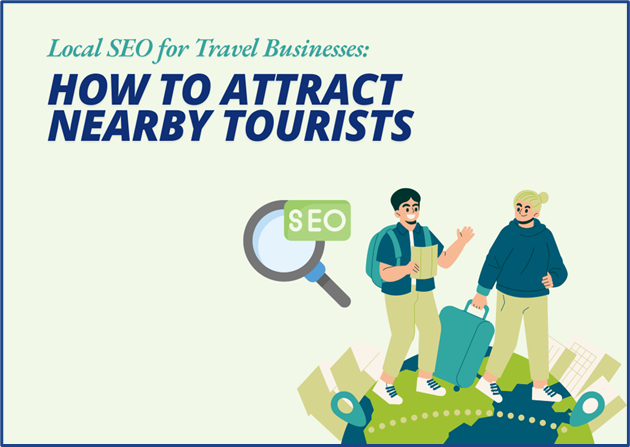Local SEO for Travel Businesses: How to Attract Nearby Tourists
Local search has become an indispensable asset for businesses looking to capture the attention of nearby tourists. As travelers increasingly rely on their smartphones to find relevant services, optimizing your online presence for local searches is no longer just a strategy—it’s a necessity. With 46% of all Google searches having local intent, mastering Local SEO for travel businesses isn’t just an option, it’s essential for capturing attention and driving engagement.
By implementing effective strategies tailored to your unique offerings and regional attractions, you can ensure that your travel business not only stands out in local search results but also connects meaningfully with the very tourists you aim to serve. Let’s dive into the essential tactics that will elevate your travel business and help you attract more visitors to your doorstep.
Geo-Targeted Keywords and Location-Based Landing Pages
Geo-targeted SEO for travel begins with a deep understanding of your local market. Geo-targeted keywords and location-based landing pages are essential for attracting tourists looking for specific services in your area. By incorporating keywords such as “best tours near [city]” or “top attractions in [region],” you can meet user search intent and direct them to relevant content.
Location-based landing pages further enhance your SEO efforts by delivering highly personalized content that highlights regional attractions and services, improving both search rankings and user engagement. For example, a travel business in South Africa could target tourists by promoting e sim south africa plan services, making it easier for international travelers to stay connected while exploring local destinations. These strategies help travel businesses connect with nearby tourists searching for relevant, localized experiences.
Optimize Google Business Profile for Maximum Visibility
Your Google Business Profile (GBP) acts as your first point of contact with potential customers. Ensure that all business details such as name, address, phone number, and operating hours are accurate and consistently updated. For travel businesses, precise information is essential for attracting tourists who rely on these details to make informed decisions.
Leverage High-Quality Visuals
Posting recent, high-quality photos of your tours, accommodations, or experiences can significantly boost your profile’s engagement. Showcasing the unique aspects of your travel business, such as destinations or services, helps draw attention and builds trust among potential customers.
Post Regular Updates and Special Offers
Keep your profile updated by frequently posting about new services, seasonal offers, or upcoming events. This only increases customer engagement and signals to Google that your business is active, which can improve your local search rankings.
Engage with Customer Reviews and Inquiries
Responding quickly to reviews and inquiries demonstrates your commitment to customer service. Whether the review is positive or negative, responding shows that you care about their feedback and builds trust. Moreover, this improves your online presence for searches in the locality, making it easier to find you for new customers.
By focusing on the areas above, you increase your Google Business Profile more significantly and enable yourself to capture and gain more tourists for your travel business.
Building Trust Through Reviews and Reputation Management
The significance of reviews is deep for the online presence of your travel business and for the attraction of tourists who are visiting nearby areas. Positive reviews fill customers with trust, increase their credibility level, and help them make decisions while choosing between multiple services.
Travelers often believe what other travelers or customers in reviews say about your offerings-tours, accommodations, and local experiences. Managing and responding to reviews, whether negative or positive, shows that you care about customer satisfaction, which may help build the strength of your business reputation. Reviews create engagement, increase user interaction, and help you in conversion while making visibility in the competitive space of travel bigger.
Local Backlink Building and Community Engagement
Local backlink building for travel businesses requires a strategic and community-focused approach. Success in this area comes from forming meaningful partnerships with local tourism boards, chambers of commerce, and regional event organizers. Collaborating with local influencers and bloggers can also provide valuable backlinks while creating authentic content that resonates with your target audience.
Mobile Optimization: Catering to On-the-Go Travelers
Mobile SEO for travelers has become non-negotiable in today’s market. With 76% of travelers using their smartphones to plan their trips, implementing mobile optimization for travel websites should be at the forefront of your digital strategy. Your mobile site should load ideally in under 3 seconds and offer intuitive navigation that makes it easy for users to find information and make bookings. Incorporating click-to-call functionality and mobile-friendly booking systems ensures a seamless experience for your on-the-go customers.
Schema Markup Implementation
Schema markup serves as a powerful tool in helping search engines better understand your content. To optimize your travel website SEO optimization, implement LocalBusiness schema to highlight your business details, TouristAttraction markup to showcase your offerings, and Event schema for any special activities or tours. Review markup helps display your ratings and reviews prominently in search results, potentially increasing click-through rates.
Analytics and Performance Tracking
By tracking the key metrics, you’ll have a clear understanding of your local SEO performance and be able to make data-driven decisions to improve visibility and engagement with nearby tourists.
1. Local Search Rankings
Monitoring where your business stands in local search results is crucial. Use tools like Google Search Console or third-party platforms to track your keyword rankings over time, focusing on geo-targeted keywords. Consistently ranking well for these keywords indicates strong local SEO performance.
2. Click-Through Rate (CTR)
CTR measures how often people click on your website after seeing it in search results. A high CTR signals that your meta descriptions and titles are compelling and relevant. Analyze your CTR to ensure that your content is attracting clicks from local searches.
3. Conversion Rates
Beyond attracting visitors, it’s essential to measure how many of those visitors convert into customers. Track metrics like bookings, inquiries, or sales to gauge how effective your local SEO efforts are at driving real business outcomes.
4. Review Engagement
The volume and quality of reviews directly impact your local SEO performance. Pay attention to how frequently users leave reviews, how promptly you respond, and the overall sentiment of the reviews. Engaging with reviews helps build credibility and improve your rankings.
5. Mobile Performance Metrics
With many tourists searching for travel services on their mobile devices, it’s critical to track your site’s mobile performance. Measure page load speed, bounce rates, and mobile traffic to ensure your site is optimized for on-the-go travelers. A smooth mobile experience directly impacts local search rankings and user satisfaction.
Conclusion
Implementing effective Local SEO strategies for tourism requires dedication and consistent effort. By focusing on these key areas and regularly updating your strategy, you can significantly improve your visibility to nearby tourists and create a strong local presence that drives business growth.
Frequently Asked Questions
- How long does it take to see results from local SEO efforts?
While initial improvements can be observed within weeks, significant results typically require 3-6 months of consistent effort. The key is to maintain accurate business information and consistently gather genuine reviews during this period.
- What are the most important ranking factors for local SEO?
The primary ranking factors include your proximity to the searcher, the relevance of your business category to the search query, the quantity and quality of your reviews, and the completeness of your Google Business Profile information.
- How often should I update my local SEO content?
Content freshness is crucial for local SEO success. Aim to post new content or updates on your Google Business Profile at least weekly, and conduct quarterly reviews of your website content to ensure all information remains current and accurate.




